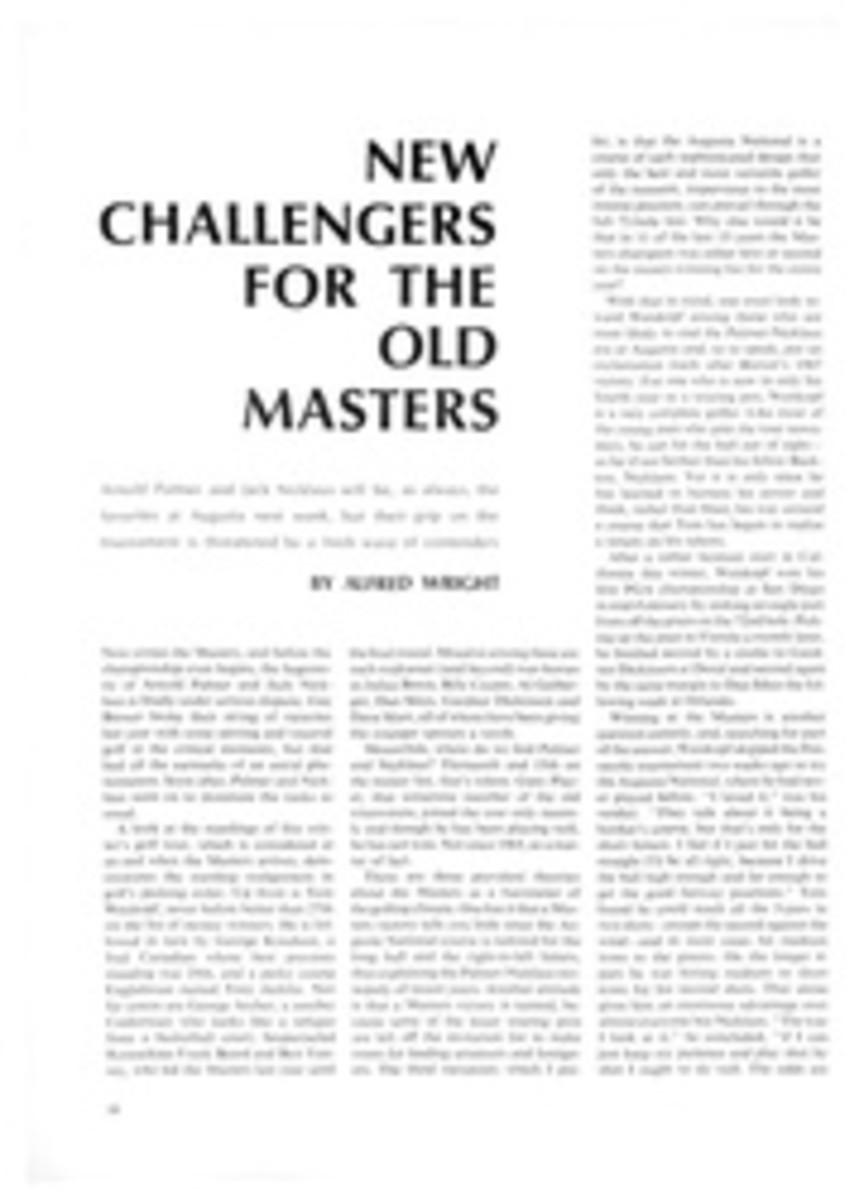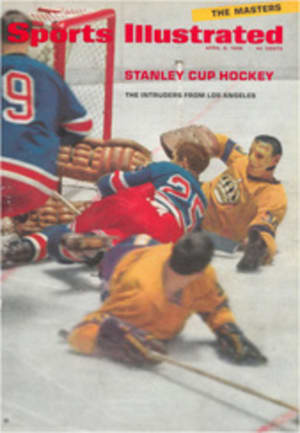
NEW CHALLENGERS FOR THE OLD MASTERS
Now comes the Masters, and before the championship even begins, the hegemony of Arnold Palmer and Jack Nicklaus is finally under serious dispute. Gay Brewer broke their string of victories last year with some stirring and visceral golf in the critical moments, but that had all the earmarks of an astral phenomenon. Soon after, Palmer and Nicklaus went on to dominate the ranks as usual.
A look at the standings of this winter's golf tour, which is considered at an end when the Masters arrives, demonstrates the startling realignment in golf's pecking order. Up front is Tom Weiskopf, never before better than 27th on the list of money winners. He is followed in turn by George Knudson, a frail Canadian whose best previous standing was 29th, and a perky young Englishman named Tony Jacklin. Not far astern are George Archer, a somber Californian who looks like a refugee from a basketball court; bespectacled Kentuckian Frank Beard and Bert Yancey, who led the Masters last year until the final round. Mixed in among these are such midcareer (and beyond) war-horses as Julius Boros, Billy Casper, Al Geiberger, Dan Sikes, Gardner Dickinson and Dave Marr, all of whom have been giving the younger sprouts a tussle.
Meanwhile, where do we find Palmer and Nicklaus? Thirteenth and 15th on the money list, that's where. Gary Player, that sometime member of the old triumvirate, joined the tour only recently and though he has been playing well, he has not won. Not since 1965, as a matter of fact.
There are three prevalent theories about the Masters as a barometer of the golfing climate. One has it that a Masters victory tells you little since the Augusta National course is tailored for the long ball and the right-to-left hitters, thus explaining the Palmer-Nicklaus monopoly of recent years. Another attitude is that a Masters victory is tainted, because some of the lesser touring pros are left off the invitation list to make room for leading amateurs and foreigners. The third viewpoint, which I prefer, is that the Augusta National is a course of such sophisticated design that only the best and most versatile golfer of the moment, impervious to the most intense pressure, can prevail through the full 72-hole test. Why else would it be that in 11 of the last 13 years the Masters champion was either first or second on the money-winning list for the entire year?
With that in mind, one must look toward Weiskopf among those who are most likely to end the Palmer-Nicklaus era at Augusta and, so to speak, put an exclamation mark after Brewer's 1967 victory. For one who is now in only his fourth year as a touring pro, Weiskopf is a very complete golfer. Like most of the young men who join the tour nowadays, he can hit the ball out of sight—as far if not farther than his fellow Buckeye, Nicklaus. Yet it is only since he has learned to harness his power and think, rather than blast, his way around a course that Tom has begun to realize a return on his talents.
After a rather hesitant start in California this winter, Weiskopf won his first PGA championship at San Diego in mid-February by sinking an eagle putt from off the green on the 72nd hole. Picking up the pace in Florida a month later, he finished second by a stroke to Gardner Dickinson at Doral and second again by the same margin to Dan Sikes the following week at Orlando.
Winning at the Masters is another question entirely, and, searching for part of the answer, Weiskopf skipped the Pensacola tournament two weeks ago to try the Augusta National, where he had never played before. "I loved it," was his verdict. "They talk about it being a hooker's course, but that's only for the short hitters. I feel if I just hit the ball straight I'll be all right, because I drive the ball high enough and far enough to get the good fairway positions." Tom found he could reach all the 5-pars in two shots—except the second against the wind—and in most cases hit medium irons to the greens. On the longer 4-pars he was hitting medium to short irons for his second shots. That alone gives him an enormous advantage over almost everyone but Nicklaus. "The way I look at it," he concluded, "if I can just keep my patience and play shot by shot I ought to do well. The odds are very much against my winning, but I'm really excited just to be playing."
Patience, however, is notably lacking in Weiskopf's golfing armory. When things are going well, Tom emits a most engaging, Midwestern country-boyish charm. If a shot comes off badly, a black cloud of gloom descends. If he messes up a tournament, as he did when a poor shot on the final hole at Doral spoiled his chance to catch Dickinson, he can be almost psychotic. His interview in the press room afterward ("I'll never play here again...worst galleries I ever saw...") was extremely embarrassing. There alone is the flaw that could hurt him under Masters pressure.
George Knudson's temperament, like his golf game, is the polar opposite of Weiskopf's. Short and skinny, he seems scarcely strong enough to drive a golf cart, and his approach to the game is almost casual. George's shots, when they are going well, are precise and beautifully struck, and with his new aluminum shafts he hits some of the crispest irons on the tour. He is not a long hitter, so the second shots at Augusta National may put a little too much pressure on his game unless he can chip and putt miraculously for four straight days. He has proved, though, that he can win against the best, not just by his rare back-to-back victories at Phoenix and Tucson this winter but at the Canada Cup in 1966 and New Orleans last year.
Then there is Tony Jacklin, whom some of his countrymen pick to be the best English golfer since Henry Cotton. Through one recent stretch in Florida, Tony played nine straight tournament rounds under 70 and at Jacksonville last week he became the first Briton ever to win a PGA tournament. He is a splendid putter, and his fine performance at last year's Masters proved the all-round soundness of his game. There is a tough cockiness to this handsome, curly-headed young Briton that has been woefully lacking among his countrymen who have futilely attempted the U.S. tournaments in recent years.
Among the youthful contenders, Archer is the most puzzling. Despite his 6'6", he has never been a long driver, or even very straight, and his long to middle irons are erratic, to put it gently. But around the green there has seldom been anyone like him. A 6-footer is a tap-in, and someone once said, "If he could putt for Nicklaus they would shoot in the 50s." Professional golfers like to belittle the great putters, but if George could not hit the other shots he would not have won two tournaments in the last year. And putting is a very large part of the game on Augusta's huge, rolling greens. Resting at home on the California ranch for his defense at Greensboro, Archer was facing the big event calmly.
"I've measured the Masters course," he declared, "and in three practice rounds just before the tournament I can learn as much as I need to know. Knowing the course is one thing. The trick is doing what you know you have to do. Right now I feel very confident of my chances. If it's my week, I can win it."
And what of those two past masters of Augusta, the men who will be uppermost in everyone's thoughts when the gun goes off on Thursday morning? Considering who they are, Palmer and Nicklaus this year have been far off form. True, Arnold finished second at Los Angeles, won at Palm Springs and was in contention until midway through the final round at Jacksonville, but in five other starts he has been 19th or worse. Jack has had a third, fifth and eighth, but at Phoenix he missed the cut and almost missed it again at Jacksonville.
Yet Jacksonville may have been the turning point for both. After a disappointing opening round there, Palmer went out to the practice tee and started hitting some drives. "My timing is off," he had been saying, "and I'm having trouble with my concentration. I'm hitting the ball all over the place." Pretty soon Nicklaus, who had had an even worse round, came along and watched.
"How do you expect to hit the ball like that?" he asked Palmer. "You're lined up all wrong." Sure enough, Palmer's stance had been opening up through the weeks, and he had been grafting correction on correction in his swing. When Nicklaus started hitting drives, Palmer watched and said, "You're doing just what I did."
The next day Palmer's 65 and Nicklaus' 30 on the back nine reflected their mutual discovery. Presumably the improvement would continue, but the Masters was no longer a foregone conclusion. A new generation and the remnants of an older one loomed forbiddingly.
TWO PHOTOS
Weiskopf (above) has the power to win at Augusta, while Knudson has the attitude.

